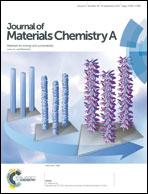Silicon nanowires loaded with iron phosphide for effective solar-driven hydrogen production†
Abstract
Iron phosphide (FeP) was introduced onto silicon nanowires (SiNWs) via precursor loading and phosphorization. The resultant SiNWs/FeP shows remarkably enhanced photoelectrochemical hydrogen production in comparison with bare SiNWs. The solar power conversion efficiency of SiNWs/FeP is as high as 2.64%, which is 94% of that of SiNWs modified with Pt particles, and is larger than those of silicon-based photocathodes loaded with other non-precious electrocatalysts such as transition metals and their chalcogenides. The faster reaction rate of the hydrogen evolution reaction (HER) on the surface of the SiNWs/FeP than that of the bare SiNWs was confirmed by an electrochemistry impedance experiment (EIS). The investigations over the EIS spectra and the flat band potential show that the onset potential of cathodic photocurrent is mainly influenced by the reaction rate of the HER on the surface of the photocathode. The transient photocurrent experiments also suggest the faster kinetics of the HER on the surface of the SiNWs/FeP in comparison with that of the bare SiNWs. This result demonstrates a convenient approach to SiNWs loaded with a highly effective electrocatalyst and its promising application potential in photoelectrochemical hydrogen generation.


 Please wait while we load your content...
Please wait while we load your content...